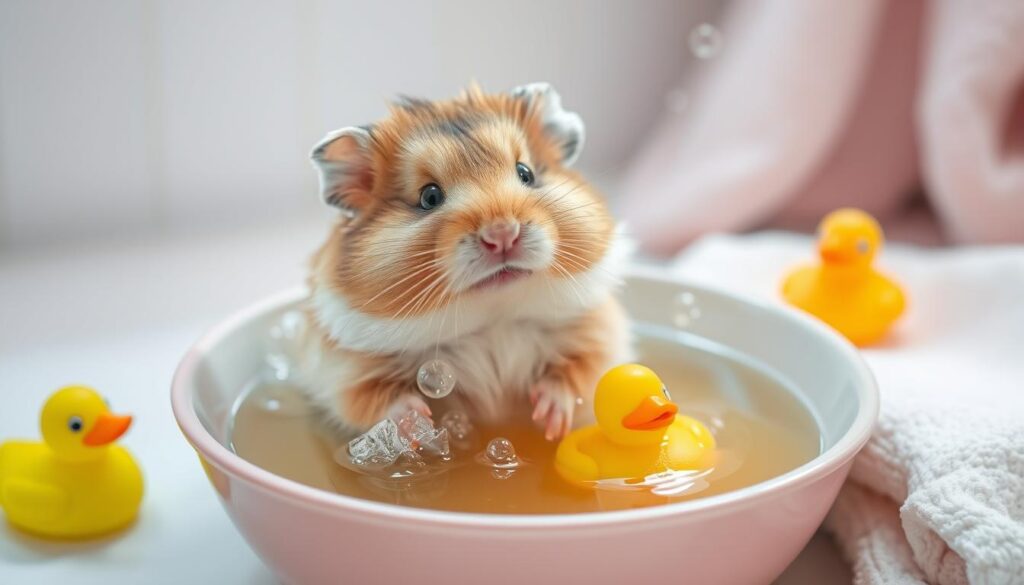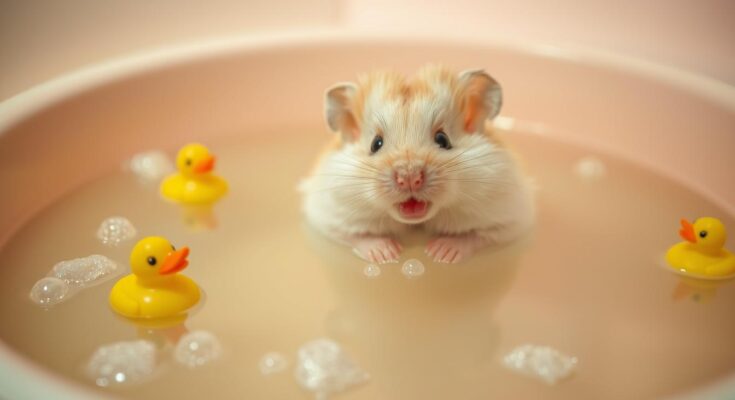As a devoted hamster owner, I’ve always been fascinated by their unique grooming habits. We might think a warm, bubbly bath is nice for them. But, hamsters are generally self-cleaning and prefer a dry, sand-based environment. In this article, we’ll see why water baths are not the best and find out the best ways to keep your hamster clean and happy.
Key Takeaways
- Hamsters should not be bathed in water unless necessary, as it can cause stress and negative behavior.
- Water can strip away the natural oils in a hamster’s coat, leading to dry and irritated skin.
- Sand baths are the preferred cleaning method for hamsters, as they are simpler and safer than water baths.
- Offering a hamster a sand bath two to three times per week can help keep their coat shiny and healthy.
- Chinchilla sand is recommended for hamster sand baths to prevent respiratory and eye issues.
Understanding Hamster’s Natural Cleaning Habits
Hamsters are amazing creatures with special grooming habits. They are mostly active at night and spend a lot of time cleaning themselves. They use their paws and tongues to keep their fur clean and healthy.
Self-Grooming Behaviors
Hamsters are very careful about their grooming. They use their front paws to clean their face, head, and ears. Their tongues also help, licking their fur to remove oils and keep it shiny.
Natural Cleaning Methods
- In the wild, hamsters roll in sand or dust to clean their fur. This is a key part of their grooming.
- Brushing their fur regularly, mainly for long-haired breeds, helps keep them healthy. It spreads natural oils and prevents mats.
- Having a sand bath area in their cage lets them clean naturally. It keeps their fur looking great.
It’s important to understand and support a hamster’s natural cleaning habits. This ensures they stay healthy and have a beautiful coat. By giving them the right resources and supporting their grooming, you can keep your hamster happy and clean.
Why Traditional Water Baths May Be Harmful
Many people think hamsters need water baths often. But, the truth is, water baths can harm these tiny pets. They can cause stress and anxiety in hamsters.
Water baths can strip away the natural oils in a hamster’s fur and skin. This can make their skin dry and irritated. It can even cause breathing problems if their fur doesn’t dry well. Plus, getting wet can make it hard for hamsters to keep warm.
Water baths can also change a hamster’s behavior. Some may get aggressive or bite during a bath. This can be dangerous for both the hamster and the owner. Unless a vet says it’s needed, it’s best to avoid water baths for hamsters.
“Hamsters never need water baths at home unless expressly prescribed by a veterinarian, highlighting how rare it is to bathe a hamster.”
Instead, hamster owners should use sand baths. These let hamsters groom themselves naturally. This keeps their coat and skin healthy. By avoiding water baths and focusing on their pets’ well-being, owners can help their hamsters live happy, stress-free lives.
Sand Baths: The Preferred Cleaning Method for Hamsters
Hamsters are delicate and need a gentle way to stay clean. Sand baths are the best way to keep them fresh and healthy. They help hamsters clean themselves like they do in the wild.
Benefits of Sand Bathing
Sand baths are great for hamsters. The sand absorbs oils and dirt, making their fur shiny. It also keeps their skin from getting dry.
Burrowing in the sand is fun for them. It’s like a spa day for hamsters.
Choosing the Right Sand
Choosing the right sand is important. Don’t use beach sand because it’s too rough. Instead, use hamster or chinchilla sand. It’s made to be safe for them.
Setting Up a Sand Bath
To set up a sand bath, use a shallow container. Fill it with 1-2 inches of sand. Put it in a place where your hamster can easily find it.
Give your hamster a sand bath 2-3 times a week. Clean and refill the sand as needed. This keeps their environment clean and healthy.
Having a sand bath lets your hamster groom itself. It’s a safe and natural way to keep them clean and happy.
| Sand Bath Frequency | Recommended Sand Type | Cleaning Precautions |
|---|---|---|
| 2-3 times per week for hamsters | Fine, dust-free chinchilla or hamster sand | Avoid leaving sand bath in cage all the time to prevent overuse |

Can You Bathe a Hamster in Warm Water
Many of us wonder if we can bathe our hamsters in warm water. Emergency water baths might be needed sometimes, but they should be used carefully. Always ask a vet before doing so.
Hamsters have special skin and don’t like water. They clean themselves with self-grooming behaviors and sand baths. Bathing them in warm water should be a last choice, as it can stress them out.
If you must bathe your hamster, use lukewarm water to prevent cold shock. Make sure not to get water in their eyes or mouth, as it can cause breathing problems. Bathe them in a warm, draft-free area in a waterproof container with high sides to keep them safe.
“Only consider bathing a hamster as a method of cleaning if other non-bathing methods won’t work and the hamster has come into contact with a toxic substance.”
Always talk to a vet before trying to clean your hamster with water. They can tell you the best way to keep your pet clean and safe. Remember, your hamster’s health is the most important thing.
Essential Equipment for Hamster Bathing
When caring for your hamster, the right tools are key. Whether it’s a sand bath or a water bath, the right supplies are vital.
Safe Bathing Containers
For water baths, use a waterproof container with high sides. A Tupperware-style plastic container works well. It keeps your hamster safe and the bath contained. Make sure it’s easy to clean and free from harmful residues.
For sand baths, choose a heavy glass or ceramic bowl. It won’t tip over. Stay away from wood or plastic, as they can be dangerous.
Appropriate Cleaning Products
Use a gentle, hamster-friendly shampoo or pet-safe wipes for washing. Avoid human shampoos, as they can harm your hamster’s skin.
For sand baths, use chinchilla sand instead of dust. It’s safer for your hamster’s health. Look for products labeled as safe for hamsters, chinchillas, and similar pets.
| Item | Recommended for Hamster Bathing |
|---|---|
| Bathing Container | Waterproof, high-sided plastic container or heavy glass/ceramic bowl |
| Cleaning Products | Hamster-friendly shampoo, pet-safe wipes, chinchilla sand |
With the right hamster bathing supplies and pet cleaning products, grooming is safe and fun for both you and your hamster.
Step-by-Step Guide to Emergency Water Bathing
Sand baths are best for cleaning hamsters, but sometimes a water bath is needed. Bathing a hamster in water should be a last choice. It can harm their skin and cause health problems if not done right. Follow these steps carefully if you must bathe your hamster in water.
- Fill a shallow container with lukewarm water, ensuring the water level reaches no higher than the hamster’s shoulders when seated.
- Use a hamster-safe shampoo or mild, gentle soap, avoiding the eyes and mouth area.
- Gently lower the hamster into the water and lightly massage the fur, taking care not to submerge the head.
- Rinse the hamster thoroughly with warm water to remove all traces of shampoo or soap.
- Bathe the hamster in a warm room without drafts to prevent chilling.
- Quickly dry the hamster with a soft, absorbent towel, ensuring they are completely dry and warm before returning them to their enclosure.
Remember, water baths should only be used as a last resort for hamsters. Following a proper hamster bath guide and pet cleaning instructions is key to keeping your furry friend healthy and happy.

“Bathing a hamster should be an absolute last resort, as it can disrupt their natural skin oils and lead to health issues if not done properly.”
Post-Bath Care and Drying Techniques
After giving your hamster a water bath, it’s key to take care of them properly. You need to dry them off right to keep them healthy and happy. The right temperature and drying methods are very important.
Temperature Control
Right after the bath, your hamster needs to be warm. This prevents them from getting sick. Make sure the area is cozy and warm. You can use a heating pad or a warm towel to dry them gently.
Drying Methods
- Towel Drying: Use a soft, clean towel to gently pat your hamster’s fur. Don’t rub or squeeze too hard, as it can hurt them.
- Air Drying: If you can, let your hamster air dry in a warm, draft-free spot. This is a gentle way to keep their fur healthy.
- Hairdryer: If all else fails, use a low-heat hairdryer on a low setting. Keep it far away and watch your hamster closely.
Choose a drying method that works for you and your hamster. Make sure they are completely dry before putting them back in their home. Watch for any signs of stress or illness after the bath. Give them extra care if needed.
“Proper post-bath care and drying techniques are essential for maintaining your hamster’s health and well-being. Take the time to ensure your pet is comfortable and dry before returning them to their habitat.”
Alternative Cleaning Solutions for Dirty Hamsters
We want our hamsters to stay clean and healthy. Traditional water baths might not be the best for them. But, there are other ways to keep their coat clean.
For small spots, use pet-friendly wipes or a warm, damp cloth. This gentle method cleans specific areas, like the rear end. It keeps your hamster clean without the stress of a full bath.
Regular brushing is also key. It keeps their coat clean and prevents tangles, which is important for long-haired breeds like Teddy Bear hamsters. As they get older, they might need more help to stay looking good.
Chew toys are good for their teeth too. They help wear down teeth that grow constantly. This prevents problems that could affect their eating and health.
“Hamsters spend up to 20% of their time grooming themselves, so they are quite skilled at maintaining their own cleanliness. Periodic assistance from their owners can help keep them looking and feeling their best.”
Using these alternative cleaning methods meets your hamster’s spot cleaning, hamster hygiene, and pet care needs. They avoid the stress of traditional water baths.
Signs Your Hamster Needs Cleaning Assistance
As pet owners, we must watch over our hamsters’ grooming needs. These small animals usually take care of themselves. But, there are times when they need our help to stay clean and healthy.
Health Indicators
Watch for a dirty rear end, as it can cause urinary or reproductive problems. Also, check for matting in long-haired breeds. Matted fur can be uncomfortable and lead to skin issues and health problems.
Behavioral Changes
Notice if your hamster’s behavior or activity levels change. If they seem tired or less interested in grooming, they might need your help.
Regularly check your hamster’s skin, nails, and teeth. Look for any signs of trouble that need vet care or grooming.
By paying attention to hamster health signs and pet grooming needs, you can keep your hamster happy and healthy. They will enjoy a great life as your companion.
Conclusion
Hamsters don’t need to be bathed often because they clean themselves well. They like to play in the sand to stay clean. It’s also important to brush and trim their nails regularly to keep them healthy.
Chew toys are key for their teeth, which grow all the time. If your hamster needs a bath, use mild, unscented products. This helps keep them calm and comfortable.
Always talk to a vet if you’re unsure about cleaning your hamster. With the right care, your hamster will stay clean and happy. Follow the hamster care tips and pet cleaning summary from this article to keep your hamster healthy and joyful.
FAQ
Q: Can hamsters be bathed in warm water?
A: Hamsters usually don’t need baths in water. They clean themselves by grooming. Water baths can be stressful and harmful.
Q: How do hamsters naturally clean themselves?
A: Hamsters groom themselves with their paws and tongues. They also use sand to clean their fur in the wild.
Q: Why are water baths not recommended for hamsters?
A: Water baths can dry out a hamster’s fur and skin. They also risk getting sick from cold water or breathing problems.
Q: What is the preferred cleaning method for hamsters?
A: Hamsters prefer sand baths. A shallow container with 1-2 inches of sand lets them clean naturally.
Q: When would a warm water bath be necessary for a hamster?
A: In emergencies or when a vet says so, a warm water bath might be needed. Be careful not to get water in their eyes or mouth. Keep them warm.
Q: What equipment is needed for bathing a hamster?
A: For baths, use a waterproof container and hamster-safe shampoo or wipes. For sand baths, a heavy bowl is best.
Q: How should a hamster be dried after a water bath?
A: Dry the hamster quickly with a towel. Keep them warm and only return to their cage when dry.
Q: What are some alternative cleaning methods for hamsters?
A: For light cleaning, use pet-friendly wipes or a damp cloth. Brushing helps keep long-haired hamsters clean.
Q: How can I tell if my hamster needs cleaning assistance?
A: Look for dirty fur, a dirty rear end, or changes in behavior. Also, check for skin or tooth problems.



